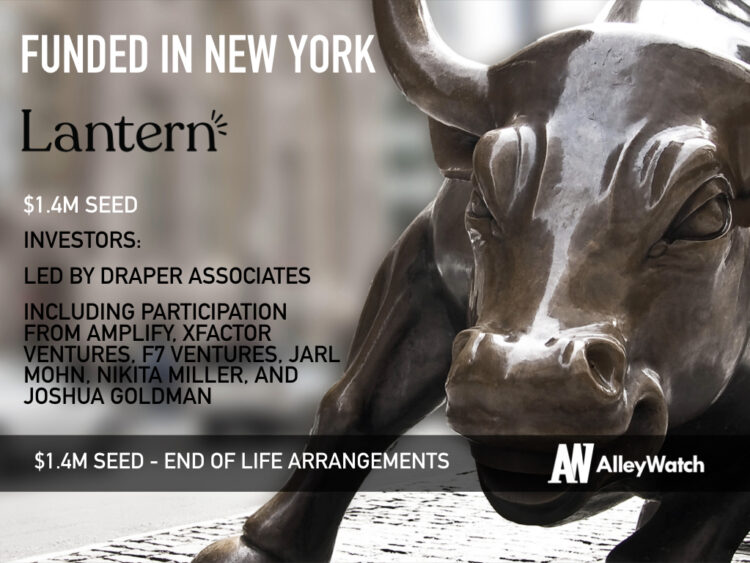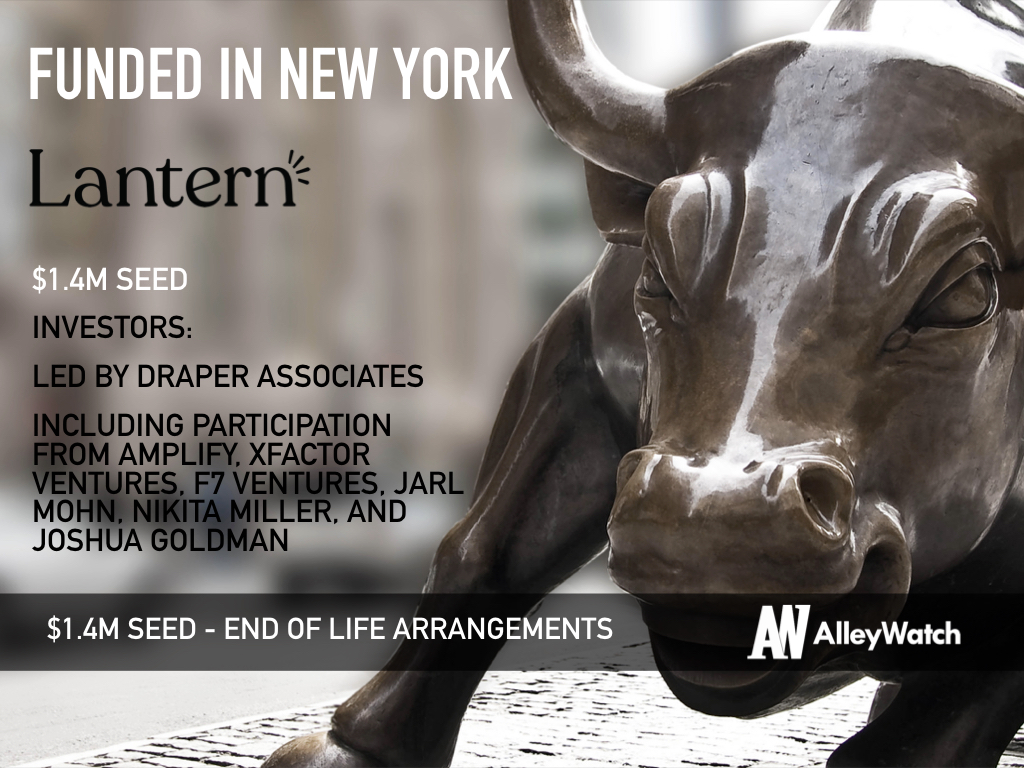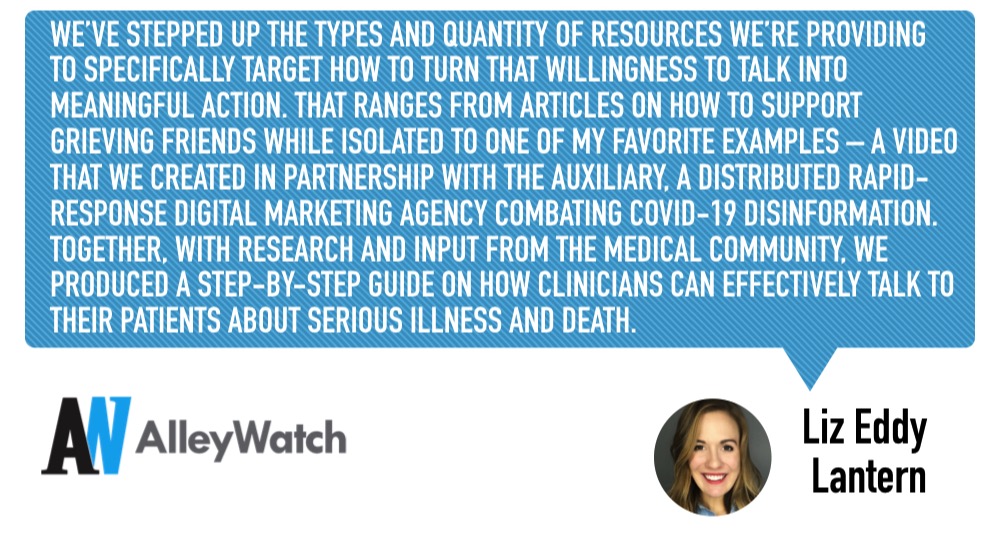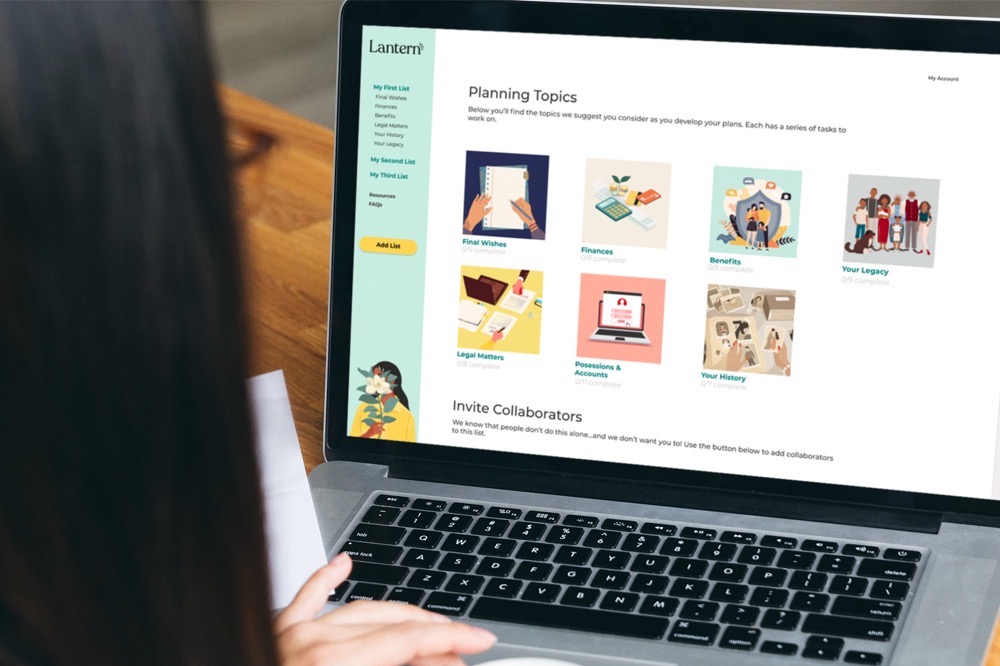The fear of death is one of the most common fears; so it’s no surprise that planning end-of-life arrangements is viewed as an uncomfortable topic that many people choose to ignore, leaving their loved ones to manage after they pass. Lantern is the modern-day end-of-life planning platform that looks at the process in holistic way. Lantern’s platform makes it easy for people to pre-plan or simply plan end-of-life arrangements. The platform at its core offers the tool to create an actionable plan and centralize documents and communications, introducing transparency and accountability. The platform places an emphasis on its user experience, design, and ensuring every interaction is handled with care and sensitivity – whether its content, customer service, or partnerships. Pricing is $27 annually for the premium option.
AlleyWatch caught up with CEO and Cofounder Liz Eddy to learn more about the inspiration for the company, the experience of fundraising for a company that’s focused on a delicate life event, future plans, and latest round of funding, which brings the total funding raised to $2.3M.
Who were your investors and how much did you raise?
Lantern closed a $1.4M seed round. Investors in the round included Draper Associates (lead), Amplify, XFactor Ventures, F7 Ventures, Jarl Mohn (NPR), Nikita Miller (Trello), and Joshua Goldman (Via).
Tell us about the product or service that Lantern offers.
Lantern, a Public Benefit Corporation, is a single source of guidance for navigating life before and after a death. Lantern offers free, custom roadmaps to make sure you or a loved one have everything in order. Whether you’re pre-planning or have recently lost someone, Lantern has all of the tools, resources, and services you need to confidently manage the process while coping with the loss of a loved one. No matter your situation, you’ll find everything you need in one place.
 What inspired the start of Lantern?
What inspired the start of Lantern?
“I think we need to do something about death.” This sentence is where Lantern began in the fall of 2018.
Having lost my dad as a young kid, when my grandmother (my dad’s mom) died in the winter of 2018, I was tasked with all of the planning that ensued. I walked into the nursing home where my grandmother lived and was confronted with two police officers, a nurse, my grandmother’s body, and a question of ‘what do you want to do?’ I pulled out my phone and Googled ‘what do you do when someone dies?’. I was confronted with outdated blog posts, ads for funeral homes, and websites that looked at only one piece of a much larger process.
I started asking questions about why a better option didn’t exist and turned to Alyssa (Alyssa Ruderman, Cofounder and COO), my go-to person for cracking a difficult challenge. When we initially started digging into the space, we assumed there would be a tool out there like Lantern — something to handhold a person through the process from start to finish with the bonus of a great design and user experience. It didn’t. So together we set out to make sure it did.
How is Lantern different?
We look at the end-of-life experience in a holistic way. We truly believe in the many amazing offerings coming from the end-of-life space and created room for Lantern users to organically discover the resources and services that work best for them. We’ve emphasized user experience, design, and entering every conversation (whether that be through content, customer service, partnerships) with empathy. We are the knowledgeable friend you lean on while navigating life before and after a death.
What market does Lantern target and how big is it?
We have two distinct markets that deeply interact with each other; pre-planners and people who are managing a death. We find our users typically skew younger (age 25-35); they’ll create their own plan and then onboard their parents and grandparents to support in their planning. On the pre-planning side alone there are about 213 million people in the US who are eligible for a Lantern pre-plan right now.
What’s your business model?
Lantern is offered direct-to-consumer for $27 a year. Additional purchasing can happen within the product experience if the user desires. We also offer Lantern as an employee or client benefit to companies ranging from banking and insurance to healthcare, senior care, and beyond.
How has COVID-19 impacted the business?
Lantern is centered on end-of-life planning, so there — fortunately or unfortunately — is a clear and tangible link between COVID-19 and the work that we do daily. Before the pandemic hit, our north star was to provide a single source of guidance for people navigating their lives before and after a death. That remains our north star in the midst of increased need.
For us personally, and for the larger end-of-life community we’re embedded within, we’ve seen an increase in traffic and in signups, but more notably, we’ve seen a greater willingness to talk about death and dying.
As a result, we’ve stepped up the types and quantity of resources we’re providing to specifically target how to turn that willingness to talk into meaningful action. That ranges from articles on how to support grieving friends while isolated to one of my favorite examples – a video that we created in partnership with The Auxiliary, a distributed rapid-response digital marketing agency combating COVID-19 disinformation. Together, with research and input from the medical community, we produced a step-by-step guide on how clinicians can effectively talk to their patients about serious illness and death.
It’s a 2-minute video that can be watched between a clinician’s car and the front doors of their hospital.
What was the funding process like?
We closed a pre-seed round of venture capital in June of 2019 and were gearing up for our seed round in March/April when Covid-19 came to a head. We had to decide: do we lean into the momentum from the relevance of our product at this moment, or do we hold off for a few months in order to focus on improving and scaling offerings? With the help of our advisors and investors, we, as founders, decided that the latter was the right choice for us.
As the story goes for many founders, when we did hit the “go” button on fundraising, we had a lot of conversations. Our raise conversations with investors tend to fall into one of three buckets:
- We totally get this, but it’s not the vertical for us
- We totally get this, but you’re too early for us right now
- We totally get this, and we’re already thinking about how to scale this together
We were lucky (and persistent) enough to have gotten enough of the right folks in bucket #3 to fill out this latest round with people and funds we are confident will propel us forward in fulfilling our brand promises. We very intentionally ended up with funding that’s tied to a diversity of thought, identity, and experience.
2021 NYC TECH INFLUENCERS | DEADLINE 1/15
NOMINATE NOW
What are the biggest challenges that you faced while raising capital?
There are a couple of obvious factors that pose challenges to Lantern when raising capital (1) being female-led and founded with less than 3% of venture capital going to women and (2) building a company around death. While many investors recognize the critical need of Lantern, we’ve certainly faced investors who are uncomfortable with the discussion or don’t align with our accessible, lower-cost approach to the space. For example, during our pre-seed raise, a VC recommended we become the “Tesla of death”.
While many investors recognize the critical need of Lantern, we’ve certainly faced investors who are uncomfortable with the discussion or don’t align with our accessible, lower-cost approach to the space. For example, during our pre-seed raise, a VC recommended we become the “Tesla of death”.
What factors about your business led your investors to write the check?
Three primary things:
- An obvious and profound need for our current offering as well as the vision for the brand
- The well-suited nature of our team to do the work
- Our approach to solving this problem – from product roadmap to our understanding of our user, to our brand.
What are the milestones you plan to achieve in the next six months?
All of our work is centered on the incredibly human need that we’re serving, so as we look to create more feature-rich versions of our product, that means we’re also looking to really connect with our users. Tens of thousands of people are turning to Lantern for guidance on end-of-life planning. These next ~6 months brings with it a laser focus on really understanding their motivations and expectations so that we can make the product even more engaging for them.
What advice can you offer companies in New York that do not have a fresh injection of capital in the bank?
Firstly, I urge anyone starting a business to think through what kind of capital you need and how it will serve your brand and customers. Venture capital is incredibly helpful for a wide range of reasons (fast growth, mentorship, community, etc.) but it is not the only way or even the right way for every business. Secondly, don’t try to do this alone! One of the things our industry has done really well is to unite and partner. Operating in silos is never as powerful as joining forces. Find companies and teams that compliment your work and push your thinking. Elevate each other, talk, listen.
Where do you see the company going now over the near term?
The anchor that grounds all of our work, near-term and long-term, is providing a single source of comfort and guidance to people who are end-of-life planning. We are creating the end-of-life planning roadmap so that we can all grieve easier.
What’s your favorite outdoor dining restaurant in NYC
Local favorite is Silver Light Tavern in Williamsburg – cozy, outdoor heating (but actually outdoors but very baffled by the fully enclosed “outdoor” seating) and really kind staff. Mesa Coyoacan in Williamsburg also never disappoints.






